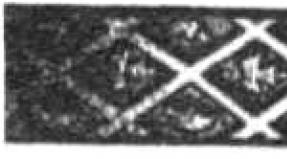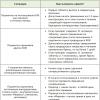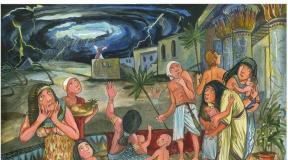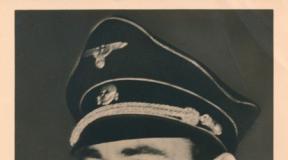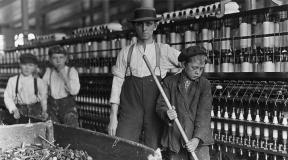I am writing a message to my homeland from the leader of the Vikings. Viking legend. Life of Scandinavian people
For several centuries, before and after the year 1000, Western Europe was constantly attacked by "Vikings" - warriors who sailed on ships from Scandinavia. Therefore, the period from about 800 to 1100 years. AD in the history of Northern Europe is called the "Viking Age". Those who were attacked by the Vikings perceived their campaigns as purely predatory, but they pursued other goals as well.
Viking detachments were usually led by representatives of the ruling elite of Scandinavian society - kings and hövdings. Through robbery, they acquired wealth, which they then divided among themselves and with their people. Victories in foreign countries brought them fame and position. Already in the early stages, the leaders also began to pursue political goals and take control of territories in the conquered countries. Little is said in the chronicles that trade increased significantly during the Viking Age, but archaeological finds attest to this. IN Western Europe there was a flourishing of cities, the first urban formations appeared in Scandinavia. The first city in Sweden was Birka, located on an island in Lake Mälaren, about 30 kilometers west of Stockholm. This city existed from the end of the 8th to the end of the 10th century; its successor in the Mälaren area was the city of Sigtuna, which today is an idyllic small town about 40 kilometers northwest of Stockholm.

The Viking Age is also characterized by the fact that many inhabitants of Scandinavia forever left their native places and settled in foreign countries, mainly as farmers. Many Scandinavians, primarily those from Denmark, settled in the eastern part of England, no doubt with the support of the Scandinavian kings and hevdings who ruled there. Large-scale Norse colonization took place in the Scottish Isles; Norwegians also sailed across the Atlantic Ocean to previously unknown, uninhabited places: the Faroe Islands, Iceland and Greenland (Even attempts were made to settle in North America). During the 12th and 13th centuries, vivid stories about the Viking Age were recorded in Iceland, not entirely reliable, but still indispensable as historical sources that give an idea of the pagan faith and way of thinking of the people of that time.

Contacts made during the Viking Age with the outside world radically changed Scandinavian society. Missionaries from Western Europe arrived in Scandinavia as early as the first century of the Viking Age. The most famous of these is Ansgar, the "Scandinavian Apostle", who was sent by the Frankish king Louis the Pious to Birka around 830 and returned there again around 850. In the late Viking Age, an intensive process of Christianization began. The Danish, Norwegian and Swedish kings realized what power Christian civilization and organization could give to their states, and carried out a change of religions. The process of Christianization was most difficult in Sweden, where at the end of the 11th century there was a fierce struggle between Christians and pagans.

Viking Age in the East.
The Scandinavians not only traveled west, but also made long journeys to the east during the same centuries. For natural reasons, it was primarily the inhabitants of the places that now belong to Sweden that rushed in this direction. Campaigns to the east and the influence of eastern countries left a special imprint on the Viking Age in Sweden. Travel to the east was also undertaken whenever possible by ship - through the Baltic Sea, along the rivers of Eastern Europe to the Black and Caspian Seas, and, along them, to the great powers south of these seas: Christian Byzantium in the territory of modern Greece and Turkey and the Islamic Caliphate in eastern lands. Here, as well as to the west, the ships sailed and oared, but these ships were smaller than those used for campaigns in the westerly direction. Their usual length was about 10 meters, and the team consisted of approximately 10 people. Larger ships were not needed to navigate the Baltic Sea, and besides, they could not move along the rivers.
Artist V. Vasnetsov "The calling of the Varangians". 862 - invitation of the Varangians Rurik and his brothers Sineus and Truvor.
This fact that the marches to the east are less known than the marches to the west is partly due to the fact that there are not many written sources about them. The letter came into use in Eastern Europe only in the later period of the Viking Age. However, from Byzantium and the Caliphate, which were the real great powers of the Viking Age from an economic and cultural point of view, there are travel descriptions contemporary to this era, as well as historical and geographical works telling about the peoples of Eastern Europe and describing trade travels and military campaigns from Eastern Europe to countries south of the Black and Caspian Seas. Sometimes among the characters in these images, we can notice the Scandinavians. As historical sources, these images are often more reliable and more complete than the Western European chronicles written by monks and bearing a strong imprint of their Christian zeal and hatred of pagans. A large number of Swedish runestones are also known from the 11th century, almost all of them are from the vicinity of Lake Mälaren; they are erected in memory of relatives who often traveled to the east. As for Eastern Europe, there is a wonderful Tale of Bygone Years dating back to the beginning of the 12th century. and talking about ancient history The Russian state is not always reliable, but always alive and with an abundance of details, which greatly distinguishes it from Western European chronicles and gives it a charm comparable to the charm of the Icelandic sagas.
Ros - Rus - Ruotsi (Rhos - Rus - Ruotsi).
In 839, an ambassador from Emperor Theophilus from Constantinople (modern Istanbul) arrived to the Frankish king Louis the Pious, who was at that moment in Ingelheim on the Rhine. With the ambassador also came several people from the people of the “Ros”, who traveled to Constantinople by such dangerous routes that they now wanted to return home through the kingdom of Louis. When the king asked in more detail about these people, it turned out that they were Svei. Louis knew the pagan Svei well, as he himself had previously sent Ansgar as a missionary to their trading city of Birka. The king began to suspect that the people who called themselves "ros" were in fact spies, and decided to detain them until he found out their intentions. Such a story is contained in one Frankish chronicle. Unfortunately, it is not known what happened to these people afterwards.
This story is important for the study of the Viking Age in Scandinavia. It and some other manuscripts from Byzantium and the Caliphate more or less clearly show that in the east in the 8th-9th centuries the Scandinavians were called "ros" / "rus" (rhos / rus). At the same time, this name was used to designate the Old Russian state, or, as it is often called, Kievan Rus (see map). The state grew during these centuries, and from it modern Russia, Belarus and Ukraine trace their origins.

The ancient history of this state is told in the Tale of Bygone Years, which was recorded in its capital, Kyiv, shortly after the end of the Viking Age. In the record of 862, one can read that unrest reigned in the country, and it was decided to look for a ruler on the other side of the Baltic Sea. Ambassadors were sent to the Varangians (that is, the Scandinavians), namely to those who were called "Rus"; Rurik and his two brothers were invited to rule the country. They came "with all Russia", and Rurik settled in Novgorod. "And the Russian land got its name from these Varangians." After the death of Rurik, the rule passed to his relative Oleg, who conquered Kyiv and made this city the capital of his state, and after the death of Oleg, Rurik's son Igor became the prince.

The legend about the calling of the Varangians, contained in the Tale of Bygone Years, is a story about the origin of the ancient Russian princely family, and how historical source highly debatable. The name "Rus" has been tried to be explained in many ways, but now the most common opinion is that this name should be compared with the names from the Finnish and Estonian languages - Ruotsi / Rootsi, which today mean "Sweden", and previously indicated peoples from Sweden or Scandinavia. This name, in turn, comes from the Old Norse word meaning "rowing", "rowing expedition", "members of the rowing expedition". Obviously, the people who lived on the western coast of the Baltic Sea were known for their sea voyages on oars. There are no reliable sources about Rurik, and it is not known how he and his "Rus" came to Eastern Europe - however, it hardly happened as simply and peacefully as the legend says. When the clan established itself as one of the ruling in Eastern Europe, soon the state itself and its inhabitants began to be called "Rus". The fact that the family was of Scandinavian origin is indicated by the names of the ancient princes: Rurik is the Scandinavian Rörek, a common name in Sweden even in the late Middle Ages, Oleg - Helge, Igor - Ingvar, Olga (Igor's wife) - Helga.

To speak more definitely about the role of the Scandinavians in the early history of Eastern Europe, it is not enough just to study a few written sources, one must also take into account archaeological finds. They show a significant number of objects of Scandinavian origin dating from the 9th-10th centuries in the ancient part of Novgorod (Rurik's settlement outside modern Novgorod), in Kyiv and in many other places. We are talking about weapons, horse harness, as well as household items, and magical and religious amulets, for example, Thor's hammers found at settlement sites, in burials and treasures.

It is obvious that in the region under consideration there were many Scandinavians who were engaged not only in war and politics, but also in trade, crafts and agriculture - after all, the Scandinavians themselves came from agricultural societies, where urban culture, just like in Eastern Europe, began to develop only during these centuries. In many places, the northerners left clear imprints of Scandinavian elements in culture - in clothing and the art of jewelry making, in weapons and religion. But it is also clear that the Scandinavians lived in societies whose structure was based on Eastern European culture. The central part of the early cities was usually a densely populated fortress - citadel or kremlin. Such fortified cores of urban formations are not found in Scandinavia, but were characteristic of Eastern Europe for a long time. The way of construction in the places where the Scandinavians settled was mainly Eastern European, and most household items, such as household ceramics, also bore a local imprint. Foreign influence on culture came not only from Scandinavia, but also from countries to the east, south and southwest.

When Christianity was officially adopted in the Old Russian state in 988, Scandinavian features soon practically disappeared from its culture. Slavic and Christian Byzantine cultures became the main components in the culture of the state, and Slavic became the language of the state and church.
Caliphate - Serkland.
How and why did the Scandinavians participate in the development of events that eventually led to the formation of the Russian state? It was probably not only war and adventure, but also a lot of trade. The leading civilization of the world during this period was the Caliphate - an Islamic state that extended east to Afghanistan and Uzbekistan in Central Asia; there, far to the east, were the largest silver mines of that time. A huge amount of Islamic silver in the form of coins with Arabic inscriptions spread throughout Eastern Europe as far as the Baltic Sea and Scandinavia. The largest number of finds of silver objects was made in Gotland. From the territory of the Russian state and mainland Sweden, primarily from the area around Lake Mälaren, a number of luxury items are also known, which indicate connections with the East that were of a more social nature - for example, details of clothing or banquet items.When Islamic written sources mention "rus" - by which, generally speaking, one can mean both the Scandinavians and other peoples from the Old Russian state, interest is shown primarily in their trading activity, although there are also stories about military campaigns, for example, against the city Berd in Azerbaijan in 943 or 944. In the world geography of Ibn Khordadbeh, it is said that Russian merchants sold the skins of beavers and silver foxes, as well as swords. They came on ships to the lands of the Khazars, and, having paid a tithe to their prince, they set off further along the Caspian Sea. Often they carried their goods on camels all the way to Baghdad, the capital of the Caliphate. "They pretend to be Christians and pay the tax established for Christians." Ibn Khordadbeh was the minister of security in one of the provinces along the caravan route to Baghdad, and he was well aware that these people were not Christians. The reason they called themselves Christians was purely economic - Christians paid a lower tax than pagans who worshiped many gods.
Besides fur, perhaps the most important commodity coming from the north were slaves. In the Caliphate, slaves were used as labor force in most public sectors, and the Scandinavians, like other peoples, could get slaves during their military and predatory campaigns. Ibn Khordadbeh relates that slaves from the country of "Saklaba" (roughly meaning "Eastern Europe") served as interpreters for the Rus in Baghdad.

The flow of silver from the Caliphate dried up at the end of the 10th century. Perhaps the reason was the fact that silver mining in the mines in the east was reduced, perhaps the war and unrest that reigned in the steppes between Eastern Europe and the Caliphate influenced. But another thing is also possible - that in the Caliphate they began to conduct experiments to reduce the silver content in the coin, and in connection with this, interest in coins in Eastern and Northern Europe was lost. Eonomics in these territories was not monetary, the value of the coin was considered according to its purity and weight. Silver coins and ingots were cut into pieces and weighed on a scale to get the price that a person was willing to pay for the goods. Silver of varying purity made this type of payment transaction difficult or nearly impossible. Therefore, the views of Northern and Eastern Europe turned towards Germany and England, where in the late period of the Viking Age a large number of full-weight silver coins were minted, which were distributed in Scandinavia, as well as in some regions of the Russian state.
However, as early as the 11th century, it happened that the Scandinavians reached the Caliphate, or Serkland, as they called this state. The most famous campaign of the Swedish Vikings in this century was led by Ingvar, whom the Icelanders called Ingvar the Traveler. An Icelandic saga is written about him, however, very unreliable, but about 25 East Swedish runestones tell about the people who accompanied Ingvar. All these stones indicate that the campaign ended in disaster. On one of the stones near Gripsholm in Södermanland you can read (according to I. Melnikova):
“Tola ordered this stone to be installed after her son Harald, brother of Ingvar.
They bravely left
far beyond the gold
and in the east
fed the eagles.
Died in the south
in Serkland.

So on many other rune stones, these proud lines about the campaign are written in verse. "To feed the eagles" is a poetic simile meaning "to kill enemies in battle". The meter used here is the old epic meter and is characterized by two stressed syllables in each verse line, and also by the fact that the verse lines are connected in pairs by alliteration, that is, repeated initial consonants and changing vowels.
Khazars and Volga Bulgars.
During the Viking Age, there were two important states in Eastern Europe dominated by Turkic peoples: the state of the Khazars in the steppes north of the Caspian and Black Seas, and the state of the Volga Bulgars on the Middle Volga. The Khazar Khaganate ceased to exist already at the end of the 10th century, but the descendants of the Volga Bulgars live today in Tatarstan, a republic within Russian Federation. Both of these states played an important role in the transfer of eastern influences to the Old Russian state and the countries of the Baltic region. A detailed analysis of Islamic coins showed that approximately 1/10 of them is an imitation and was minted by the Khazars or, more often, by the Volga Bulgars.The Khazar Khaganate early adopted Judaism as the state religion, and the Volga Bulgar state officially adopted Islam in 922. In this regard, the country was visited by Ibn Fadlan, who wrote a story about his visit and meeting with merchants from Russia. The most famous is his description of the burial of the heading of the Rus in the ship - a burial custom characteristic of Scandinavia and also found in the Old Russian state. The funeral ceremony included the sacrifice of a slave girl, who was raped by the warriors from the squad before they killed her and burned her along with their hevding. This is a story full of brutal details that can hardly be guessed from the archaeological excavations of the graves of the Viking Age.

Varangians at the Greeks in Miklagard.
The Byzantine Empire, which in Eastern and Northern Europe was called Greece or the Greeks, according to the Scandinavian tradition was perceived as the main goal of campaigns to the east. In the Russian tradition, links between Scandinavia and the Byzantine Empire also figure prominently. The Tale of Bygone Years contains detailed description way: "There was a way from the Varangians to the Greeks, and from the Greeks along the Dnieper, and in the upper reaches of the Dnieper it was dragged to Lovot, and along Lovot you can enter Ilmen, the great lake; Volkhov flows out of the same lake and flows into the lake the great Nevo (Ladoga ), and the mouth of that lake flows into the Varangian Sea (Baltic Sea)."The emphasis on the role of Byzantium is a simplification of reality. The Scandinavians came primarily to the Old Russian state and settled there. And trade with the Caliphate through the states of the Volga Bulgars and the Khazars should have been of the most important economic importance for Eastern Europe and Scandinavia during the 9th-10th centuries.

However, during the Viking Age, and especially after the Christianization of the Old Russian state, the importance of ties with the Byzantine Empire increased. This is evidenced primarily by written sources. For unknown reasons, the number of finds of coins and other objects from Byzantium is relatively small in both Eastern and Northern Europe.
Around the end of the 10th century, the Emperor of Constantinople established a special Scandinavian detachment at his court - the Varangian Guard. Many believe that the beginning of this guard was laid by those Varangians who were sent to the emperor by Kyiv Prince Vladimir in connection with his adoption of Christianity in 988 and his marriage to the emperor's daughter.
The word vringar originally meant a people bound by an oath, but in the late Viking Age it became a common name for the Scandinavians in the east. Waring in the Slavic language became known as Varangian, in Greek - Varangos (varangos), in Arabic - Varank (warank).
Constantinople, or Miklagard, the great city, as the Scandinavians called it, was incredibly attractive to them. The Icelandic sagas tell of many Norwegians and Icelanders who served in the Varangian guard. One of them, Harald the Severe, became King of Norway on his return home (1045-1066). Swedish runestones of the 11th century often speak of a stay in Greece than in the Old Russian state.
On the old path leading to the church at Ede in Uppland, there is a large stone with runic inscriptions on both sides. In them, Ragnvald talks about how these runes were carved in memory of his mother Fastvi, but above all he is interested in telling about himself:
"These runes commanded
carve Ragnvald.
He was in Greece
was the leader of a detachment of warriors.
Soldiers from the Varangian Guard guarded the palace in Constantinople and took part in military campaigns in Asia Minor, the Balkan Peninsula and Italy. The country of the Lombards, mentioned on several runestones, implies Italy, the southern regions of which were part of the Byzantine Empire. In the port suburb of Athens, Piraeus, there used to be a huge luxurious marble lion, which was transported to Venice in the 17th century. On this lion, one of the Varangians, during a holiday in Piraeus, carved a runic inscription in a serpentine shape, which was typical of Swedish runestones of the 11th century. Unfortunately, when it was discovered, the inscription was so badly damaged that only a few words can be read.

Scandinavians in Gardarik in the late period of the Viking Age.
At the end of the 10th century, as already mentioned, the flow of Islamic silver dried up, and instead, a flood of German and English coins poured east into the Russian state. In 988 the prince of Kyiv and his people took the quantities to Gotland, where they were also copied, and to mainland Sweden and Denmark. Several belts have even been discovered in Iceland. Perhaps they belonged to people who served with the Russian princes.
Relations between the rulers of Scandinavia and the Old Russian state during the 11th-12th centuries were very lively. Two of the great princes of Kiev took wives in Sweden: Yaroslav the Wise (1019-1054, formerly reigned in Novgorod from 1010 to 1019) married Ingegerd, the daughter of Olaf Schötkonung, and Mstislav (1125-1132, formerly reigned in Novgorod from 1095 to 1125) - on Christina, daughter of King Inga the Old.

Novgorod - Holmgard and trade with the Saami and Gotlanders.
Eastern, Russian influence also reached the Saami in northern Scandinavia in the 11th-12th centuries. In many places in Swedish Lapland and Norrbotten there are places of sacrifice on the banks of lakes and rivers and near rocks of bizarre shape; there are deer antlers, animal bones, arrowheads, and also tin. Many of these metal objects come from the Old Russian state, most likely from Novgorod - for example, the fitting of Russian belts of the same kind that were found in southern Sweden.
Novgorod, which the Scandinavians called Holmgard, acquired great importance over the centuries as a trading metropolis. The Gotlanders, who continued to play an important role in Baltic trade in the 11th-12th centuries, created a trading post in Novgorod. At the end of the 12th century, the Germans appeared in the Baltic, and gradually the main role in the Baltic trade passed to the German Hansa.
End of the Viking Age.
On a simple casting mold for cheap jewelry, made from a bar and found at Timans in Rum in Gotland, two Gotlanders at the end of the 11th century carved their names, Urmiga and Ulvat, and, in addition, the names of four distant countries. They let us know that the world for the Scandinavians in the Viking Age had wide borders: Greece, Jerusalem, Iceland, Serkland.
It is impossible to name the exact date when this world shrank and the Viking Age ended. Gradually, during the 11th and 12th centuries, the ways and connections changed their character, and in the 12th century, travel deep into the Old Russian state and to Constantinople and Jerusalem ceased. When the number of written sources in Sweden increased in the 13th century, the campaigns to the east became only memories.
In the Elder Edition of the Westgötalag, written in the first half of the 13th century, in the Chapter on Succession, there is, among other things, the following statement regarding one who is acquired abroad: He does not inherit anyone while he is sitting in Greece. Did the Westgets really still serve in the Varangian guard, or did this paragraph remain from bygone times?
In Gutasag, an account of the history of Gotland recorded in the 13th or early 14th century, it is said that the first churches on the island were consecrated by bishops on their way to or from the Holy Land. At that time there was a way to the east through Russia and Greece to Jerusalem. When the saga was being written, the pilgrims made their way around Central or even Western Europe.

Translation: Anna Fomenkova.
Do you know that...
The Scandinavians who served in the Varangian Guard were probably Christians - or they converted to Christianity during their stay in Constantinople. Some of them made pilgrimages to the Holy Land and Jerusalem, which was called Yorsalir in the Scandinavian language. The runestone from Brubyu to Täby in Uppland is placed in memory of Eystein, who went to Jerusalem and died in Greece.Another runic inscription from Uppland, from Stacket in Kungsengen, speaks of a determined and fearless woman: Ingerun, daughter of Hord, ordered runes to be carved in memory of herself. She goes east and to Jerusalem.
In 1999, the largest hoard of silver objects dating back to the Viking Age was found on Gotland. Its total weight is about 65 kilograms, of which 17 kilograms are Islamic silver coins (approximately 14,300).
The material used drawings from the article.
games for girls
Movies and fiction formed the image of the Vikings, whom people represent as savages in skins, leather armor, helmets with horns on it. But all this is fiction of directors and writers, in fact, the Vikings did not wear such headdresses, they were free farmers, they conquered neighboring territories, they built wooden drakkars.
The Vikings lived on the Scandinavian Peninsula, and already at the end of the 8th century. began to attack neighboring England and France. Residents of other parts of Europe, who first encountered the Danes and Norwegians, called them Normans, that is, northern people; askemanns or ash people; madhus - pagan monsters. In Kievan Rus, the Vikings were called Varangians, in Ireland two names for the inhabitants of Scandinavia were common - finngalls (light strangers) and dubgalls (dark strangers), in Byzantium - varangs.
The term "Viking": versions
There is no unequivocal opinion among linguists and historians as to why the Vikings were called this particular word. According to one version, the verb wiking in Scandinavia meant "to go to the sea to get wealth and glory."
According to another version, the term appeared due to the province (region) of Vik, which is located in Norway. It is located near Oslo. In medieval sources, the inhabitants of the area were not called Vikings, but vestfaldingi or vikverjar.
The term Viking could also have come from the word vik, which among the Scandinavians meant a bay or bay, and the Vikings were those who hid whether they lived in the bay. There is also a version that speaks of m, that the Viking could mean wic / vicus, which denoted a trading point, a camp, fortified from different sides, a city.
According to the latest research by Swedish scientists, the name "Viking" could come from vikja - to turn and deviate. Vikings were, in this context, people who sailed away from home, left home, sea warriors and pirates who went on a campaign for prey. The term vikja was used to refer to a predatory campaign, so the people who participated in such events were Vikings. In the chronicles of Iceland, this word denoted seafarers who were rude, bloodthirsty, unbridled, robbed and attacked other ships.
The first Anglo-Saxon settlements in the British Isles
At the beginning of the 4th c. AD Germanic tribes, represented by the Jutes, Angles and Saxons, and living at the mouth of the Elbe River, began to make the first aggressive campaigns. The objectives of the military campaigns were:
- Capture of England and its settlement;
- Settlement in the region of Western Europe;
- The expulsion of the Romans from the occupied territories.
Most of all, the Germans caused problems for the Roman garrisons in the British Isles, forcing the latter to defend themselves. In 407, the Romans and fleet are recalled from England to defend Italy. As a result, the settlements of the Saxons, Jutes and Angles began to increase in size and become stronger.
At the end of the 5th c. AD, Wessex was conquered. There is a legend that this was done by King Cerdic, who sailed to the islands in a flotilla of five ships. After that, the Angles and Saxons began to quickly move deep into the British Isles, displacing the Romans and Celts from there. The consequence of this was the gradual conquest of the colony, the process was finally completed by the 6th century. In the occupied territories, the Angles and Saxons created small kingdoms.
The Celts, who adopted Christianity from the Romans, began to move to the mountainous regions of Wales, and then began to move to mainland Europe. For example, one of the settlements of the Celts on the continent was called Britain, gradually turning into Brittany.
England changed the Vikings and the way they lived. If at the time of arrival and then for several decades, the Anglo-Saxon tribes lived by robbery and piracy, then they gradually began to move to a more sedentary way of life.
Already at the end of the 8th c. Seafaring was not the main occupation of the Vikings. Its place was taken by agriculture, which was the basis for the development of the society of the descendants of the former northern peoples.
Campaigns and conquests
The coast of the North Sea, which was left by the Jutes, Angles and Saxons in the 6th century, began to be settled by the Danes, who came from Halland and Skåne (territories in southwestern Sweden). Two centuries later, they formed a kingdom, which in 800 turned into a large and powerful state of the Danes. The kingdom included Norway and Sweden. In order to protect themselves from the attacks of the Franks, a defensive rampart was built, which was called the Danevirke. The country at that time was ruled by King Gottrick, who was in power until 810. After his death, the kingdom ceased to exist, as a result of which the Danes and the Norwegians began to engage in predatory campaigns and conquer neighboring territories. This era lasted for about three hundred years.
Among the main reasons that contributed to the conquest campaigns of the Vikings, it is worth noting such as:
- At the disposal of the Normans were a lot of ships that were excellent for sailing on the seas and rivers;
- The Vikings had the navigational knowledge that was necessary for trekking on the high seas;
- The Danes and Norwegians mastered the tactics of surprise attacks on opponents from the sea, as well as moving ships and troops along the rivers. The inhabitants of the British Isles and continental Europe did not have such knowledge and skills, therefore they did not make trips to Scandinavia;
- Viking opponents fought internecine wars all the time, which weakened their states politically and economically. All this facilitated the conquest and contributed to successful military campaigns against the Angles, Saxons and Franks.
Viking campaigns began at the end of the 8th century, when the first groups of Norwegians began to penetrate the sea coast of England. The Normans plundered islands and monasteries, bringing rich booty to Scandinavia.
All Viking attacks took place according to a planned and well-established pattern. Without any military operations from the sea, the ships of the Varangians approached the shores, then the soldiers landed on the coast and began to rob. Everything happened very quickly, after themselves the Vikings left fires, killed. The ships allowed them to leave England, so the inhabitants of the British Isles could not pursue them.
The Scandinavians used the same scheme for campaigns in England in the 1920s. 9th c. In 825, they landed on the Frisian coast, and began to rob, kill, and seize new territories. Already in 836, London was captured by the Vikings for the first time. In 845, Hamburg fell to the Danes. The chronology of further Viking campaigns is as follows:
- Mid 9th c. - the re-capture of London and Canterbury, the German settlement on the Xanten Rhine, after which it was the turn of Bonn and Cologne. The Scandinavians did not bypass France, capturing Aachen, Rouen and Parisg. The capture of London and Paris happened many times, so the rulers of the kingdoms decided that the only way to save the cities from robberies was to pay off. As a result of one of them, the Vikings simply lifted the siege of Paris, and settled in the northeastern regions of France. At the beginning of the 10th c. Charles the Third gave this territory as hereditary possession to a Norwegian, whose name was Rolland. The area where the Vikings lived began to be called Normandy;
- In the 860s. Scotland and East Anglia were conquered, in which they created their own state of Denlo. It included part of Mercia, Essex, East Anglia, Northumbria. The country was destroyed by the Anglo-Saxons only at the end of the 870s;
- In the 10th century campaigns became less frequent, as Denmark and Norway began to create their own centralized states with strong rulers. At the beginning of the 11th c. the Danes subjugated Norway;
Danes after the conquest of the Norwegians again began to attack England. The traces of their conquests were stones on which runes were applied. The first campaigns of the Normans at the end of the 10th century. - the beginning of the 11th century. were unsuccessful, most of the soldiers were destroyed. The situation began to change only by 1016, when the Vikings subjugated England. Only by the beginning of the 1040s. Anglo-Saxon rulers began to carry out retaliatory offensives. By the middle of the 11th century. The Vikings were temporarily expelled from England. In 1066, England was conquered by the Vikings who lived in Normandy. Their leader, William the Conqueror, organized a crossing across the strait connecting the British Isles and continental Europe. On October 14, 1066, a major battle took place between the Vikings and the Angles at Hastings. The Normans finally conquered England, which made it possible to stop predatory attacks, begin the development of feudalism on the islands, and gain access to the throne and power in the kingdom.
Conquest of Greenland and Iceland
Campaigns were organized in the Mediterranean Sea. The navigational skill of the Vikings allowed them to reach Byzantium, which happened in 895. The Normans sailed to the shores of America, Iceland and Greenland.
The first Norsemen landed in the Hebrides in 620. Two hundred years later they settled in the Faroe Islands, Orkney and Shetland. In 820, the Vikings founded their own state in Ireland, which existed near modern Dublin. The Norman kingdom in Ireland lasted until 1170.
In the early 860s. Swede Gardar Svafarsson, whose name is preserved in the chronicles, brought to his native Scandinavia the inheritance of his wife from the Hebrides. On the way, his ship was carried to the northern coast of Iceland. There, the Swede and his team spent the winter, getting acquainted with the peculiarities of this island territory. Iceland was actively conquered by the Norwegians from the beginning of the 870s, when King Harald the Fair-Haired came to power. Not everyone liked his reign, so the Norwegians began to explore Iceland. Until 930, from 20 thousand to 30 thousand inhabitants of the kingdom moved here. In Iceland, the Vikings were mainly engaged in agriculture, cattle breeding and fishing. Household items, seeds, pets were transported from Scandinavia.
Information about when the Vikings began to conquer Greenland, and when they discovered America, came from numerous Icelandic sagas of the 13th-14th centuries.
According to historical data and documents, in the early 980s. Eirik, a resident of Iceland, sailed away from home because he was accused of murder. During the voyage, he reached the shores of Greenland, founding the settlement of Brattalid. Information about this island began to reach the Norwegians gradually, who several times explored the coast of Greenland, discovering the Labrador Peninsula. During one of the voyages, the Vikings discovered the area, which they called Vinland, i.e. Grape Country. This name was given to the new territory due to the fact that a lot of wild grapes and maize grew here, salmon was found in the rivers. Fish was distributed in reservoirs along the 41st latitude, and grapes along the 42nd parallel. Scientists have established that the city of Boston is now located in this place. But the Vikings could not conquer America-Vinland, because, having discovered it once, they did not record the exact coordinates of its location. Therefore, they simply could not swim to it again.
But the Vikings mastered Greenland very actively. There were almost 300 Scandinavian courtyards here. It was difficult to increase the number of settlements because there was not enough forest. It was brought from Labrador, but sailing to the peninsula was full of dangers due to the rather dry climate. Therefore, building materials were brought from Europe, which was expensive. Vessels did not always reach Greenland. By the 14th century Viking settlements on the island ceased to exist. Archaeologists find the remains of Viking ships, forests from Europe, burial places of the nobility, which indicates that the Vikings actively settled in this territory.
The influence of the Vikings on the history of Europe
The Scandinavians undertook campaigns in other parts of continental Europe, for example, in Eastern Europe. The most famous conquests are the conquest of Kyiv and its surrounding territories, the foundation of the Rurik dynasty. In addition, the merits of the Vikings in Europe include:
- They taught the conquered peoples new traditions of shipbuilding;
- The opening of trade routes previously unknown to Europeans;
- Contributed to the development of military affairs, woodworking;
- Contributed to the development of shipping and navigation;
- Viking navigation was one of the most advanced in the world at that time, so medieval states used the knowledge and achievements of the Vikings in science, technology, geography;
- The Vikings founded many cities in Europe.
In addition, almost all royal dynasties in medieval states were founded by people from Scandinavia.
Vikings - early medieval Scandinavian
which sailors,In the 8th-11th centuries, they made sea voyages from Vinland to Biarmia and from the Caspian Sea to North Africa. For the most part, these were free peasants who lived on the territory of modern Sweden, Denmark and Norway, who were pushed outside their native countries by overpopulation and a thirst for easy money. Religiously, the vast majority are pagans.
Swedish Vikings and Vikings from the Baltic coast - traveled to the east and appeared in ancient Russian and Byzantine sources under the name of the Varangians.
Norwegian and Danish Vikings - moved mostly to the west and are known from Latin sources under the name of the Normans.
A look at the Vikings from within their society is provided by the Scandinavian sagas, but this source should be approached with caution due to the often late date of their compilation and recording.
Settlements

Cloth



Peasant clothes of the Scandinavians of the 9th-11th centuries consisted of a long woolen shirt, short baggy trousers, stockings and a rectangular cape. Vikings from the upper classes wore long pants, socks and capes in bright colors. Woolen mittens and hats were in use, as well as fur hats and even felt hats.
Women from high society usually wore long clothes, consisting of a bodice and a skirt. Thin chains hung from buckles on clothes, to which scissors and a case for needles, a knife, keys and other small items were attached. Married women put their hair in a bun and wore conical white linen caps. Unmarried girls had their hair tied up with a ribbon. The Vikings wore metal jewelry to indicate their position. Belt buckles, brooches and pendants were very popular. Screw bracelets made of silver and gold were usually given to a warrior for conducting a successful raid or for winning a battle.
In popular culture, Vikings are often depicted with horned helmets. In fact, archaeologists cannot say exactly what shape the Viking helmets were. The concept of horned helmets is associated with drawings found in burials (for example, the Oseberg ship). Now scientists are inclined to believe that if helmets with horns were used, then only for ritual purposes, and not in battle.
Weapon

 The most common type of weapon a spear about 150 cm long. Such a spear could both stab and chop. Scandinavian axes were wide, symmetrically diverging blade . The Scandinavian sword was a long, double-edged blade with a small guard . Only the upper third of the blade was sharpened, the lower two thirds were weakly or not sharpened at all.
The most common type of weapon a spear about 150 cm long. Such a spear could both stab and chop. Scandinavian axes were wide, symmetrically diverging blade . The Scandinavian sword was a long, double-edged blade with a small guard . Only the upper third of the blade was sharpened, the lower two thirds were weakly or not sharpened at all.
ships

The Vikings were skilled shipbuilders who created the most advanced ships of their era. Since it was customary in Scandinavian society to bury warriors along with their boats, archaeologists have a good idea about the characteristics of Viking ships. Specialized museums have been opened in Oslo, Roskilde and some other cities. Among the most famous are the Gokstad and Oseberg ships. Both were discovered over a hundred years ago and are now on display at the Drakkar Museum in Oslo. From the sagas it is known that ships went into battle under a banner with the image of a black raven.
The Viking fleet consisted mainly of warships called Drakkars and merchant ships of the Knorr. Warships and merchant ships allowed men to visit overseas countries, and settlers and explorers crossed the sea in search of new lands and riches. Numerous rivers, lakes and other waterways in Scandinavia gave the Vikings an easy and convenient way to travel. In Eastern Europe, in the conditions of numerous portages, single-deck boats were common, which were designed to enter shallow rivers and dock on gently sloping banks, which allowed the Vikings to move very quickly and take their enemies by surprise.
Vikings in England
8 June 793 CE e. The Vikings landed on the island of Lindisfarne in Northumbria, destroying and devastating the monastery of St. Cuthbert. This is the first Viking attack clearly recorded in written sources, although it is clear that Scandinavians have visited British shores before. Since at first the Vikings used the tactics of pinning (quickly plundered and retreated into the sea), the chroniclers did not attach much importance to their raids. However, the Anglo-Saxon Chronicle mentions a raid by pirates of unknown origin on Portland in Dorset in 787.

A major success for the Danish Vikings was the conquest of the Anglo-Saxon kingdoms and the occupation of the western and northern parts of England. In 865, the sons of the Danish king Ragnar Lothbrok brought a large army to the shores of England, christened by the chroniclers "the great army of the pagans." In 870-871. the sons of Ragnar subjected the kings of East Anglia and Northumbria to cruel execution, and their possessions were divided among themselves. Following this, the Danes set about conquering Mercia.
The king of Wessex, Alfred the Great, was forced to conclude a truce with the Danes first (878), and then a full-fledged peace treaty (about 886), thereby legitimizing their possessions in Britain. Jorvik became the English capital of the Vikings. Despite the influx of fresh forces from Scandinavia in 892 and 899, Alfred and his son Edward the Elder successfully resisted the Danish conquerors, clearing East Anglia and Mercia from them by 924. Scandinavian dominance in remote Northumbria continued until 954 (Eadred's war with Eirik Bloodaxe).
A new wave of Viking raids on British shores began in 980. It culminated in the conquest of England in 1013 by the Danish Vikings of Sven Forkbeard. In 1016-35. Canute the Great was at the head of the united Anglo-Danish monarchy. After his death, the Wessex dynasty, in the person of Edward the Confessor, regained the English throne (1042). In 1066, the British repulsed another Scandinavian invasion, this time led by the Norwegian king Harald Stern (see the Battle of Stamford Bridge).
The last of the Danish monarchs to claim English lands Knud's nephew, Sven Estridsen. In 1069, he sent a huge fleet (up to 300 ships) to help Edgar Etling in the fight against William the Conqueror, and the next year he personally arrived in England. However, having captured York and meeting William's army, he preferred to receive a large ransom and returned with the fleet back to Denmark.
Movement to the West

The Scandinavian colonization of Iceland began under Harald Fair-Haired (about 900), who, with his onslaught on the small Norwegian kings, forced them to look for luck "in the western seas." Moving west, the Vikings settled in the Orkney, Shetland, Hebrides, Faroe Islands, and the Isle of Man. The Icelandic pioneers were led by Ingolf Arnarson. The Icelander Eric the Red settled in Greenland in the 980s, and his son Leif Eriksson founded the first settlement in Canada around 1000 (see L "Ans-o-Meadows"). There is a theory that in their movement to the west, the Scandinavians reached Minnesota (see Kensington Runestone).
The Battle of Clontarf (1014) ended Scandinavian hopes of conquering all of Ireland. Nevertheless, the British, who invaded Ireland in the 12th century, found that the baptized Scandinavians were still in charge in the coastal regions of the island.
Vikings and Franks

With the growth of feudal fragmentation, the defense against the Vikings became more and more difficult, and they reached Paris in their raids. King Charles the Simple finally decided in 911 to give the Scandinavian leader Rollon the north of France, which was called Normandy. This tactic proved to be effective. The raids stopped, and the squad of northerners soon disappeared into the local population. Rollon was descended in a straight line from William the Conqueror, who led the Norman conquest of England in 1066. At the same time, the Norman family of Hauteville conquered the south of Italy, laying the foundation for the Sicilian kingdom.
Eastern Europe

The main object of interest of the Vikings was the river routes, through which it was possible to get to the Arab Caliphate through the portage system. Their settlements are known on the Volkhov (Staraya Ladoga, Rurik's ancient settlement), the Volga (Sarskoye ancient settlement, the Timerevsky archaeological complex) and the Dnieper (Gnezdovsky barrows). The places of concentration of Scandinavian burial grounds, as a rule, are several kilometers away from the city centers where the local population, mainly Slavic, settled, and in many cases from the river arteries themselves.
In the 9th century, the Vikings ensured trade with the Khazars along the Volga with the help of a proto-state structure, called by some historians the Russian Khaganate. Judging by the finds of coin hoards, in the 10th century the Dnieper became the main trade artery, the main trading partner instead of Khazaria was Byzantium. According to the Norman theory, from the symbiosis of the newcomer Varangians (Rus) with the Slavic population, the state of Kievan Rus was born, headed by the Rurikovichs - the descendants of Prince (King) Rurik.
In the lands of the Prussians, the Vikings held in their hands the trading centers of Kaup and Truso, from where the “amber route” began in the Mediterranean. In Finland, traces of their long presence have been found on the shores of Lake Vanajavesi. In Staraya Ladoga, under Yaroslav the Wise, Jarl was Regnvald Ulvson. The Vikings traveled to the mouth of the Northern Dvina for furs and explored the Zavolotsky path. Ibn Fadlan met them in the Volga Bulgaria in 922. Through the Volga-Don portage at Sarkel, the Rus descended into the Caspian Sea (see the Caspian campaigns of the Rus). For two centuries they fought and traded with Byzantium, concluding several agreements with it (see the campaigns of Russia against Byzantium). The military trade routes of the Vikings can be judged by runic inscriptions found on the island of Berezan and even in the Hagia Sophia in Constantinople.
Termination of sea voyages

Individual adventurers from Scandinavia in the 11th century were still employed by the Byzantine emperors (see the Varangian guards) and the Old Russian princes (see the Eimund saga). Historians refer to the last Vikings on the Norwegian throne as Olaf Haraldson and Harald the Severe, who laid down his head while trying to conquer England. Ingvar the Traveler, who died during the expedition on the shores of the Caspian Sea, was one of the last distant overseas trips in the spirit of the ancestors. Having adopted Christianity, yesterday's Vikings organized in 1107-1110. own crusade to the Holy Land.
History of the Vikings
In France they were called Normans, in Russia - Vikings. Vikings - this is how the people who lived on the territory of present-day Norway, Denmark and Sweden called themselves from about 800 to 1100 AD.
Wars and feasts are two favorite pastimes of the Vikings. Swift sea robbers on ships bearing sonorous names, for example, the "Ocean Bull", "Wind Raven", raided the coast of England, Germany, Northern France, Belgium - and took tribute from the conquered. Their desperate berserk warriors fought like mad, even without armor. Before the battle, the berserkers gnashed their teeth, biting the edges of their shields. The cruel gods of the Vikings - aces were pleased with the warriors who died in battle.
But it was these ruthless warriors who discovered the islands of Iceland (in the ancient language - “ice land”) and Greenland (“green land”: then the climate there was warmer than now!). And the Viking leader Leif the Happy in 1000, sailing from Greenland, landed in North America, on the island of Newfoundland. The Vikings called the open land Vinland - "rich". Due to skirmishes with the Indians and among themselves, the Vikings soon left and forgot America, lost contact with Greenland.
And their songs about heroes and travelers have survived to our time - sagas and the Icelandic parliament Althing - the first popular assembly in Europe.
The beginning of the Viking Age is considered to be the year 793. This year there was a famous Norman attack on the monastery, located on the island of Lindisfarne (north-east of Great Britain). It was then that England, and soon the whole of Europe, learned about the terrible "northern people" and their dragon-headed ships. In 794 they "visited" the nearby island of Wearmus (there was also a monastery there), and in 802-806 they reached the Isles of Man and Iona (the western coast of Scotland).
Twenty years later, the Normans gathered a large army to march on England and France. In 825 the Vikings landed in England, and in 836 London was sacked for the first time. In 845, the Danes captured Hamburg, and the city was so ruined that the episcopate, located in Hamburg, had to be moved to Bremen. In 851, 350 ships again appeared off the coast of England, this time London and Canterbury were captured (and of course plundered).
In 866, several ships were carried by a storm to the coast of Scotland, where the Normans had to spend the winter. In the following year, 867, the new state of Danlo (Danelaw) was formed. It included Northumbria, East Anglia, part of Essex and Mercia. Danlo existed until 878. At the same time, a large fleet attacked England again, London was again captured, and then the Normans moved to France. In 885, Rouen was captured, and Paris was under siege (in 845, in 857 and 861, Paris had already been sacked). Having received a ransom, the Vikings lifted the siege and withdrew to the northwestern part of France, which in 911 was transferred to the Norwegian Rollon. The region was named Normandy.
At the beginning of the tenth century, the Danes again tried to capture England, which they succeeded only in 1016. The Anglo-Saxons managed to throw off their power only after forty years, in 1050. But they did not have time to enjoy freedom. In 1066, a huge fleet under the command of William the Conqueror, a native of Normandy, attacked England. After the Battle of Hastings, the Normans took over England.
In 861, the Scandinavians learned about Iceland from the Swede Gardar Svafarsson. Shortly thereafter, in 872, the unification of Norway by Harald Fairhair began, and many Norwegians fled to Iceland. According to some sources, between 20,000 and 30,000 Norwegians moved to Iceland before 930. Later they began to call themselves Icelanders, thus separating themselves from the Norwegians and other Scandinavian peoples.
In 983, a man named Eirik Raud (Redhead) was expelled from Iceland for murder for three years. He went in search of a country that was rumored to be seen to the west of Iceland. He managed to find this country, which he called Greenland ("Green Country"), which sounds rather strange in relation to this snowy and cold island. In Greenland, Eirik founded the settlement of Brattalid.
In 986, a certain Bjarni Bardsson sailed from Iceland, intending to get to Greenland. He stumbled across unknown land three times until he reached the southern coast of Greenland. Upon learning of this, Leif Eiriksson, the son of Eirik Raud, repeated Bjarni's journey, reaching the Labrador Peninsula. Then he turned south and, walking along the coast, found a place he called "Vinland" ("Grape Country").
Presumably this happened in the year 1000. According to the results of the work carried out by scientists, Leif Eiriksson's Vinland was located in the area of \u200b\u200bmodern Boston.
After the return of Leif, Thorvald Eiriksson, his brother, went to Vinland. He lived there for two years, but in one of the skirmishes with the local Indians he was mortally wounded, and his comrades had to return to their homeland.
Leif's second brother, Thorstein Eiriksson, also tried to reach Vinland, but he failed to find this land.
There were only about 300 homesteads in Greenland. The lack of forest created great difficulties for life. The forest grew on Labrador, which was closer than in Iceland, but everything needed had to be brought from Europe, due to the very difficult sailing conditions to Labrador. Settlements in Greenland existed until the 14th century.
History of the Vikings
VIKINGS - (Normans), sea robbers, immigrants from Scandinavia, who committed in the 9th-11th centuries. hikes up to 8000 km long, maybe even long distances. These bold and fearless people reached the borders of Persia in the east, and the New World in the west.
The word "Viking" comes from the Old Norse "Vikingr". There are a number of hypotheses regarding its origin, the most convincing of which raises it to "vik" - fiord, bay. The word "viking" (lit. "man from the fiord") was used to refer to robbers who acted in coastal waters, hiding in secluded bays They were known in Scandinavia long before they became notorious in Europe.The French called the Vikings the Normans, or various variants of the word (Norsmans, Nortmanns - lit. "people from the north"); the British called all Scandinavians indiscriminately Danes, and the Slavs, Greeks, Khazars, Arabs called the Swedish Vikings Rus or Vikings.
Wherever the Vikings went - to the British Isles, to France, Spain, Italy or North Africa - they ruthlessly plundered and seized foreign lands. In some cases, they settled in conquered countries and became their rulers. The Danish Vikings conquered England for some time, settled in Scotland and Ireland. Together they conquered a part of France known as Normandy. The Norwegian Vikings and their descendants established colonies on the North Atlantic islands of Iceland and Greenland and founded a settlement on the coast of Newfoundland in North America, however, which did not last long. The Swedish Vikings began to rule in the east of the Baltic. They spread widely throughout Russia and, descending along the rivers to the Black and Caspian Seas, even threatened Constantinople and some regions of Persia. The Vikings were the last Germanic barbarian conquerors and the first European pioneer navigators.
There are different interpretations of the reasons for the violent outburst of Viking activity in the 9th century. There is evidence that Scandinavia was overpopulated and many Scandinavians went abroad in search of their fortune. The rich but undefended cities and monasteries of the southern and western neighbors were easy prey.
It was hardly possible to get a rebuff from the scattered kingdoms in the British Isles or the weakened empire of Charlemagne, absorbed by dynastic strife. During the Viking Age, national monarchies gradually consolidated in Norway, Sweden and Denmark. Ambitious leaders and powerful clans fought for power. The defeated leaders and their supporters, as well as the younger sons of the victorious leaders, shamelessly accepted unhindered robbery as a way of life. Energetic young men from influential families usually gained authority through participation in one or more campaigns. Many Scandinavians engaged in robbery in the summer, and then turned into ordinary landowners. However, the Vikings were attracted not only by the lure of prey. The prospect of establishing trade opened the way to wealth and power. In particular, immigrants from Sweden controlled trade routes in Russia.
The English term "Viking" comes from the Old Norse word vkingr, which could have several meanings. The most acceptable, apparently, is the origin of the word vk - bay, or bay. Therefore, the word vkingr is translated as "man from the bay." The term was used to refer to robbers hiding in coastal waters long before the Vikings gained notoriety in the outside world.
However, not all Scandinavians were sea robbers, and the terms "Viking" and "Scandinavian" cannot be considered as synonyms. The French usually called the Vikings Normans, and the British indiscriminately referred to all Scandinavians as Danes. Slavs, Khazars, Arabs and Greeks, who communicated with the Swedish Vikings, called them Russ or Varangians.
Definitions from encyclopedias:
VIKINGS, Scandinavians - participants in sea trade, predatory and conquest campaigns at the end of the 8th - the middle of the 11th centuries. to European countries. In Russia they were called Varangians, and in Western Europe they were called Normans (Scand. Northman - "northern man"). In the 9th century captured Northeast England, in the 10th century. - Northern France (Normandy). Reached North America.
Encyclopedia of Cyril and Methodius:
About three centuries from 800 to 1050 AD. e. Viking warriors sailed on their ships, terrorizing Europe. They sailed from Scandinavia in search of silver, slaves and land. The Vikings mainly attacked Britain and France while they invaded Russia. The Vikings explored many unknown lands by sailing the vast Atlantic Ocean.
The Vikings or Normans are northern peoples who came from Scandinavia from the territory of modern Norway, Sweden and Denmark. The Vikings lived, as a rule, in coastal areas, and their life was closely connected with the sea. To date, there is no consensus on the origin of the name "Viking". According to one theory, the name "Vikings" (from the Old Norse vik - bay) means the inhabitants of the coast of the bay. The Vikings often went on campaigns for the purpose of robbery and robbery, which earned them the fame of cruel warriors. Medieval period from the 8th to the 11th centuries. sometimes called the Viking Age - because of their frequent raids on the countries of Europe.
At the end of the 8th century, the first detachments of the Vikings left their homeland in search of new lands. At first, they attacked foreign countries, killing people, robbing and burning cities, stealing livestock, food and other property, which is why they were known as ruthless and cruel robbers. For several years, the Vikings carried out raids on the vast territories of the British Isles and the northern coast of France, and over time they began to increasingly attempt to conquer other countries. In the ninth century many Viking settlements appeared on the coast of England, Scotland and Ireland (it was thanks to the Vikings that Dublin flourished, a Celtic settlement conquered in 830, the modern capital of Ireland). A huge army of Vikints invaded eastern England with 350 ships, but King Alfred the Great managed to stop the invaders and protect the southern part of the country. However, after the campaigns of two great leaders - Sven Forkbeard in 1013 and Knut the Great in 1016, the Scandinavian warriors captured all of England for a while.
 Courage and resourcefulness
Courage and resourcefulness
The success of the campaigns and conquests of the Vikings was largely determined by the appropriate equipment. Unexpected attacks from the sea became possible thanks to the long boats (langskip) invented by them - fast and light wooden ships that "flowed" from wave to wave. They were equipped with a sail and several pairs of oars, at which strong warriors sat. The Vikings also built smaller boats (knorr) used to transport goods. Brutal warriors have invented new battle tactics. To frighten the enemies, the berserkers were the first to rush into battle - warriors drunk with magical brews, seized with a thirst for blood and attacking with screams that made the blood run cold.
Viking ships were called drakars. They were about 30 meters long and could hold up to 80 soldiers.
Fearless travelers
Brave sailors, the Vikings made long journeys. Floating in rivers, they went far into the depths of the continents. Several times they attacked Paris, reached Russia (where they were called Varangians) and Constantinople. The Vikings founded settlements on many islands, incl. in Iceland. Based solely on observations of stars and birds, they were able to cross the stormy Atlantic Ocean. The Vikings visited Greenland many times, and in 1000 even sailed to North America long before Columbus, although they did not establish settlements there.
The Vikings were skilled craftsmen and gifted bards. A testament to their craftsmanship is the magnificent finish of household items. The artistic inclinations of the Vikings were reflected in music and poetry. The Vikings wrote long sagas - unusual stories about heroes, great friendship and hatred, revenge and traditions. Some sagas have survived to our times, but history has not preserved the names of their authors.
Viking women usually took care of the house, although they had much more rights than women in other societies of that time.
The Vikings were famous for their fine armor. They especially prized elaborately decorated swords and formidable axes, although they also used metal-pointed spears and bows. Many Vikings had round, light, but very strong shields made of several layers of leather and characteristic helmets. Leaders sometimes wore metal chain mail.
gods and heroes
The beliefs of the Vikings corresponded to their warlike character. They believed that the end of the world would come in the great battle of the gods and giants, and courageous warriors after death ended up in a country called Valhalla, where time passed in battles and feasts. The dead Vikings were buried along with their weapons, and the bodies of the most courageous warriors were placed in ships that were buried in the ground or burned. Some elements of the beliefs of this people can still be found in European culture today. For example, in English language the word Thursday, i.e. "Thursday", comes from the name of Thor - the deity of the Vikings, the powerful lord of the storm and war.
Read also...
- Maps of the Simbirsk province Old maps of the Simbirsk province by Schubert
- We clean coins at home: with soap, Coca-Cola, citric acid, electrolysis method
- Detailed map of the Oryol region with villages, cities, towns and districts Schubert's map of the Oryol province 1850
- What are the signs advised to do if you find a cross
